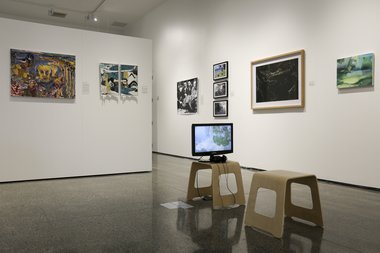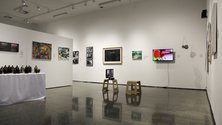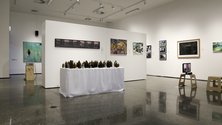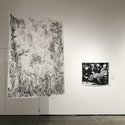John Hurrell – 16 August, 2016
The event has a clearly stated agenda, for while ‘artistic merit' is part of it, this is not a general art competition making claims for pluralism in terms of different parallel art ideologies or thinking patterns. It is thematically quite definite, and very much flavour of the day internationally. There are about thirty-six finalists, about a third of all submitted entries: a mix of photographs, texts, sound recordings, videos, sculptures and paintings. There is too much work overall.
Howick
Selected group exhibition
Estuary Art Awards 2016 - Tenth Anniversary
Selected and judged by Jon Bywater
29 July - 27 August 2016
As a competition for artists, set up in Howick with the aim of show-casing ecological issues to do with the Tamaki estuary, this exhibition has been going for ten years now. The current venue, the Malcolm Smith Gallery (in the heart of the Uxbridge Arts and Culture Centre) and directed by Balamohan Shingade, has only recently opened, and this year, Jon Bywater - well known writer, lecturer, and sometime artist himself - is the judge and selector. He awarded a winner ($5000), a runner up ($2000) , and two merits ($150 Gordon Harris Vouchers).
The event has a clearly stated agenda, for while ‘artistic merit’ is part of it, this is not a general art competition making claims for pluralism in terms of different parallel art ideologies or thinking patterns. It is thematically quite definite, and very much flavour of the day internationally. There are about thirty-six finalists, about a third of all submitted entries: a mix of photographs, texts, sound recordings, videos, sculptures and paintings. There is too much work overall.
My view is that this is not the sort of show - if you have a serious interest in contemporary art - that you would make a pilgrimage out to Howick to see. Much of it (despite being selected) is too amateurish and too sentimental for that (especially the photography). If you go to the trouble of visiting, it is because you are curious about the space and Shingade‘s plans for it, or are curious about Bywater and what his preferences might be. Being an erudite and very clear writer, Bywater’s accompanying printed comments pinpoint what he finds compelling about the works he picked.
He gave Emily Parr’s video work, Te Wai Mokoia, the main prize, the work being a recorded conversation about environmental issues between the artist and locals, Rangimarie Te Moti and her grand-daughter Yvonne Dainty. It ranges in content from the impending forced shift from their house on the western shore due to Glen Innes’ controversial housing redevelopment, to a discussion elaborating on the sinister changes in plant and animal populations in the waterway, that they have observed gradually occurring over the past fifty years
Cushla Donaldson got the runner up prize with her Stop the Contamination flier, a small essay on the details of the pollution written by Matthew Theunissen that incorporates research from scientists, Drs Ghada Abrahim and Jarrod Walker. Along with the commissioning of Theunissen’s informative essay, Donaldson has arranged for the playing of the trash metal Slayer hit Raining Blood, every 66 minutes 6 seconds over the p.a. in the gallery and in the council café, a bit of apocalyptic humour with very serious intent.
One of the other works which caught my eye was AD Schierning‘s Trace elements, a list in a vertical column of the various contaminants detected in the silt in a 2002 study. Schierning’s artist statement elaborates on the chemical pollutants in detail, while the artwork itself has their symbols written in weedy letters in diluted silt on a sheet of paper. It’s a nice idea for an artwork but visually not taken far enough. The names for instance could have been written out in full in a thick font so that the sludgy letters were more dramatic and conspicuous. Such a strategy could have upstaged Donaldson’s brilliant idea, if it had happened.
One aspect that needs commenting on is that information-based (political/historical) exhibitions like this need a takeaway flier, a free or cheap catalogue listing works, media and artists’ statements, packaged with the judge’s comments. Visitors often don’t like to read wall texts closely in a gallery space when they are standing and their legs might be aching; they really just want to get home where it is warm. They are far more likely to read a catalogue closely in a domestic environment, where they are relaxed with food and drink and comfy furniture. A publication’s detailed information and written argument might even inspire them to return for a second visit.
John Hurrell





 Two Rooms presents a program of residencies and projects
Two Rooms presents a program of residencies and projects Advertising in this column
Advertising in this column



This Discussion has 0 comments.
Comment
Participate
Register to Participate.
Sign in
Sign in to an existing account.